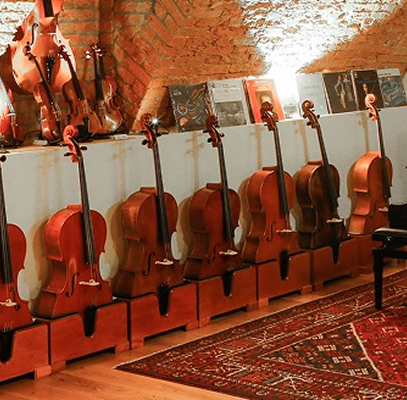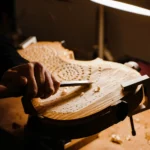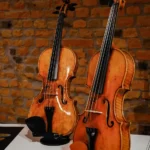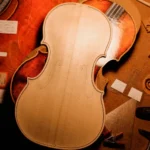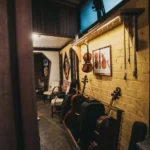Top 10 Violin Makers of the 1700s: A blog about famous violin makers in history
Back to BlogViolins came around long ago, but their popularity boomed in the 16th century triggered by the most famous violin makers in history. Since then, the instrument has been leading in the classical genre, not to mention that it provided us with some of classical music’s greatest melodies and composers.
These master makers became popular because of their marvelous work as luthiers. Their contribution to the art of violin-making is unquestionable and therefore, their methods and models inspire makers up to the present. Now, we bring you a list of 10 of these famous violin makers from the 1700s, who had a huge role in violin-making history!
Antonio Stradivari (1644‑1737)
The greatest name of the violin makers, Antonio Stradivari, was a noble Cremonese citizen, and despite not coming from a luthier family, he started his apprenticeship at a young age, supposedly with Nicola Amati.
He started out in the violin, following Amati’s style, but soon he developed his own style, creating his finest instruments! Little by little, he built his reputation by selling his instruments to the royal families and notable citizens of that time.
The tone, responsiveness, elegance of design, visual appeal, and precision of Stradivari crafts were higher than any other at the time.
His life as a luthier is clearly divided into 4 periods:
- The Amatisé: 1660 – 1690
- The Long Pattern: 1690 – 1700
- The Golden Period: 1700 – 1720
- The Late Period: 1720 – 1737
Alessandro Gagliano (1640 – 1725)
Allessandro was the first of this long-lived family of violin makers from the region of Napoli, who created violins that were used by many violinists for almost two centuries. Unlike most of the Gagliano family, Allessandro decided not to follow the Stradivari model and follow his own. His instruments exhibit great character and originality, and even his varnish was distinctive; rich, limpid, and deep red in color. But his cellos are the ones that stand out.
Nicola and Gennaro Gagliano, the sons of Alessandro were fine craftsmen, but they were greatly influenced by Stradivari and Amati. Little is known about Alessandro because up until recently, the biographical information on the violin makers of the Neapolitan school was not available.
Carlo Bergonzi (1683 – 1747)
Carlos Bergonzi is one of the greatest Cremonese makers, overshadowed only by Antonio Stradivari and Giuseppe Guarneri del Gesu. Carlos Bergonzi is thought to have learned the art of violin making from Giuseppe Guarneri filius Andreae, and made his own shop around 1720. His instruments from the period 1730-1740 are particularly well known for their clean-cut scrolls.
At some point, Stradivari shifted from the traditional Amati style, influencing other violin makers of that time to do the same, including Bergonzi. Some of the characteristics of his work are the big open-cut soundholes low positioned, the narrow c bouts, and the scrolls, sharply defined. Musicians say that his instruments offer a combination of Guarneri and Strad qualities, and its characteristics lie somewhere between the two.
Matteo Goffriller (1659 ‑1742)
Matteo Goffriller was born in the Alpine town of Bressanone, close to Bolzano, and is considered to be the father of the Venetian school. In 1685, he moved to Venice to become an apprentice with Mathias Kaiser, and soon after he got married to Kaiser’s daughter and by 1690 had inherited his teacher and father-in-law’s business.
Goffriller influenced respected makers such as Domenico Montagnana, Santo Serafin and Carlo Tononi. His work later became a salient attribute of the Venetian style, his cellos are his most favored works today. Some may say they are superior to all but those of Stradivari and Montagnana.
Joseph Guarnerius del Gesù (1698 – 1744)
Del Gesù was the greatest master of the celebrated Guarneri family of violin makers. He was the grandson of Andrea and son of Giuseppe Giovanni Battista.
You find the term “del Gesù” in his labels, incorporated by the characters I.H.S and a Roman cross, due to the Greek abbreviation for Jesus and it indicates veneration for the Holy Name.
From 1730 on, he had his triumph years and did some impressive impeccable work.
Despite his short career, he created some of the best-sounding instruments in history. After the death of his father and Stradivari, he came out of the shadow and made some of the most expressive violins of his career, and each one seemed like experimentation towards the search for the perfect sound.
It seems Guarneri’s creativity and daring in design and construction more than compensated for his corresponding lack of interest in the details of the workmanship.
Matthias Klotz (1656 – 1743)
Matthias Kloz is considered by many to be the founder of the violin industry in Mittenwald, Germany, and a statue of him was erected there. He studied in Padua, Italy for 6 years with Giovanni Railich. Matthias’ work, which clearly shows the influence of Stainer, was characterized by good craftsmanship considering the mediocre materials. And the tone of his instruments is noteworthy. A good number of violins made by Mattias, and other members of the prolific Klotz family, are in existence.
With the experienced eye of a master, his work is dazzlingly delicate given his corpulent physique and powerful hands.
Pietro Guarneri (1695-1762)
Known as Peter Guarnerius of Venice, was the older brother of Joseph Guarnerius del Gesu. Given the Stradivari family’s dominance in Cremona at the time, Pietro decided it was best for business to leave for Venice.
After del Gesù, he was the other star of the family. The grain of his bellies is often wide, the distance between the F-holes is conspicuous, the F-holes themselves are rounder and less Brescian, the scrolls are beautifully cut, and the varnish is superb, from its golden tints to its pale red.
Carlo Antonio Testore (1693 – 1765)
Carlo was the eldest son of Carlo Giuseppe Testore and seems to have been less accomplished than his father in violin making. His instruments still show the mark of Grancino visible in his father’s work, but often with false purfling on the back and flat-backed pegboxes.
His careless work may have been the reason for the somewhat premature death of his father, which left Carlo Antonio and his 16-year-old brother Paolo in charge of the business. And then, Giovanni assisted his father, Carlo Antonio, toward the end of his career.
Giovanni Battista Guadagnini (1711 – 1786)
Born in a city very close to Cremona, Piacenza, during the Strad Golden Period. His first sign of being a violin maker is that he was an apprentice of his father. However, there are no concrete evidences if his father made violins, so it remains unknown how exactly he started. Despite this, he was a great luthier. After 44 years of labor, experimentation and perseverance, he earned the title of the greatest violin maker of the second half of the 18th century.
Pietro Guarneri Mantova (1655 – 1720)
Few of his instruments survive, they are almost all violins of superior workmanship and elegance, but as a result, his career languished. Some characteristics of his works were the f-holes display an individual style, with large open circles and elegant curves. The material and the varnishing were also great, and the Amati influence is visible in his work, but with touches and elements of Stradivari and Stainer.
Pietro’s influence is evident in the work of later violin makers such as Balestrieri and Camilli.

